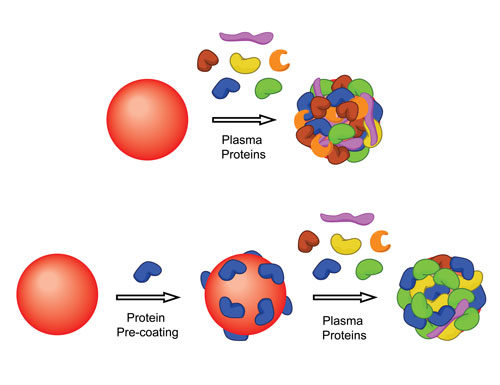| Posted: Oct 28, 2015 | |
Pre-coating nanoparticles to better deal with protein coronas |
|
| (Nanowerk Spotlight) A major goal in nanomedicine is to make nanoparticles with the capability of in vivo targeting for both imaging and delivery of therapeutic biomolecules in the human body. One strategy to obtain a high targeting yield is to functionalize the surface of nanoparticles with targeting ligands – like antibodies or aptamers – that enhance the binding of nanoparticles to receptors on the target cells and facilitate nanoparticle uptake by receptor-mediated endocytosis. | |
| Previous reports have shown that when nanoparticles enter the blood stream, the proteins that adsorb onto nanoparticles when they enter the body form a protein corona that hinders interactions between the targeting ligands on the nanoparticles and their binding partners on the cells' surface (read more in our previous Nanowerk Spotlights: "Personalized protein coronas result in different therapeutic or toxic impacts of identical nanoparticles" and "The cellular response to nanomaterials depends on the environment"; also see these papers in Chemical Communications: "Protein corona significantly reduces active targeting yield" and Nature Nanotechnology: "Transferrin-functionalized nanoparticles lose their targeting capabilities when a biomolecule corona adsorbs on the surface."). | |
| To address this issue, scientists have developed a strategy that enables directing the formation of protein coronas on nanoparticles that are enriched in plasma proteins with natural targeting capabilities. This involves pre-coating nanoparticles with selected proteins prior to their exposure to the desired biological environment. | |
| "One strategy that has been proposed to address this challenge is to exploit the protein corona itself for targeted nanoparticle delivery," Morteza Mahmoudi, an assistant professor at Tehran University of Medical Sciences, who heads the Laboratory of Nano-Bio Interactions, and a Visiting Professor at Stanford University's School of Medicine, tells Nanowerk. "We were motivated to investigate the feasibility and limitations of this emerging strategy because few studies have probed whether plasma proteins with natural targeting capabilities could be selectively recruited to the nanoparticles' surfaces and used to direct nanoparticle uptake by desired cell types." | |
| The team's findings show that the surface of a nanoparticle can be engineered to promote the formation of a hard protein corona that is enriched with desired proteins, but a lack of control over the conformations and accessibility of the recruited proteins is currently a limitation of this approach. | |
| These results have been published in the October 9, 2015 online edition of Biomaterials ("Impact of protein pre-coating on the protein corona composition and nanoparticle cellular uptake"). | |
 |
|
| Schematic of directing protein corona formation by engineering the surfaces of nanoparticles. Pre-coating nanoparticles with select proteins prior to their exposure to plasma can promote the binding of desired plasma proteins that have targeting capabilities (yellow species). However, the recruitment of plasma proteins with targeting capabilities may not promote nanoparticle uptake because these desired proteins are covered by other plasma proteins (green species). (Image: Laboratory of Nano-Bio Interactions, Tehran University of Medical Sciences) | |
| The team, led by Mary L. Kraft, an associate professor at the University of Illinois at Urbana-Champaign, and Mahmoudi, demonstrated that by pre-coating nanoparticles with proteins that promote the adsorption of desired plasma proteins, they can direct the formation of a protein corona on the surface of a nanoparticle that is enriched in plasma proteins with natural targeting capabilities. | |
| "However, the corona proteins with targeting capabilities did not significantly promote nanoparticle uptake by the desired cells because they were screened by other proteins in the hard corona," says Kraft. "Therefore, to form a functional corona with targeting capabilities, the desired plasma proteins must not only be enriched in the corona, but they must also be positioned such that their binding motifs are accessible to the receptors on the surfaces of the target cells." | |
| These results indicate that strategies for producing protein coronas with targeting capabilities on nanoparticles must not only promote the recruitment of the desired plasma proteins to the nanoparticles? surfaces, but also control their orientations so that they can access binding partners on the target cells. | |
| With further development, nanoparticles functionalized with protein coronas that have targeting capabilities might be used for diagnostic applications – by sensitive targeted imaging – and therapeutics by selectively transporting cytotoxic, i.e., anticancer, drugs to the diseased cells in the body, which would reduce the undesired side effects of these therapies. | |
| "Future directions of our research would be to develop strategies that enable controlling the conformations and accessibility of the desired proteins that are recruited to the protein corona so that they can interact with their binding partners on the target cells," conclude Kraft and Mahmoudi. "We expect that preventing undesired plasma proteins from adsorbing on top of the desired plasma proteins is going to be a major challenge." | |
 By
Michael
Berger
– Michael is author of three books by the Royal Society of Chemistry:
Nano-Society: Pushing the Boundaries of Technology,
Nanotechnology: The Future is Tiny, and
Nanoengineering: The Skills and Tools Making Technology Invisible
Copyright ©
Nanowerk LLC
By
Michael
Berger
– Michael is author of three books by the Royal Society of Chemistry:
Nano-Society: Pushing the Boundaries of Technology,
Nanotechnology: The Future is Tiny, and
Nanoengineering: The Skills and Tools Making Technology Invisible
Copyright ©
Nanowerk LLC
|
|
|
Become a Spotlight guest author! Join our large and growing group of guest contributors. Have you just published a scientific paper or have other exciting developments to share with the nanotechnology community? Here is how to publish on nanowerk.com. |
|
